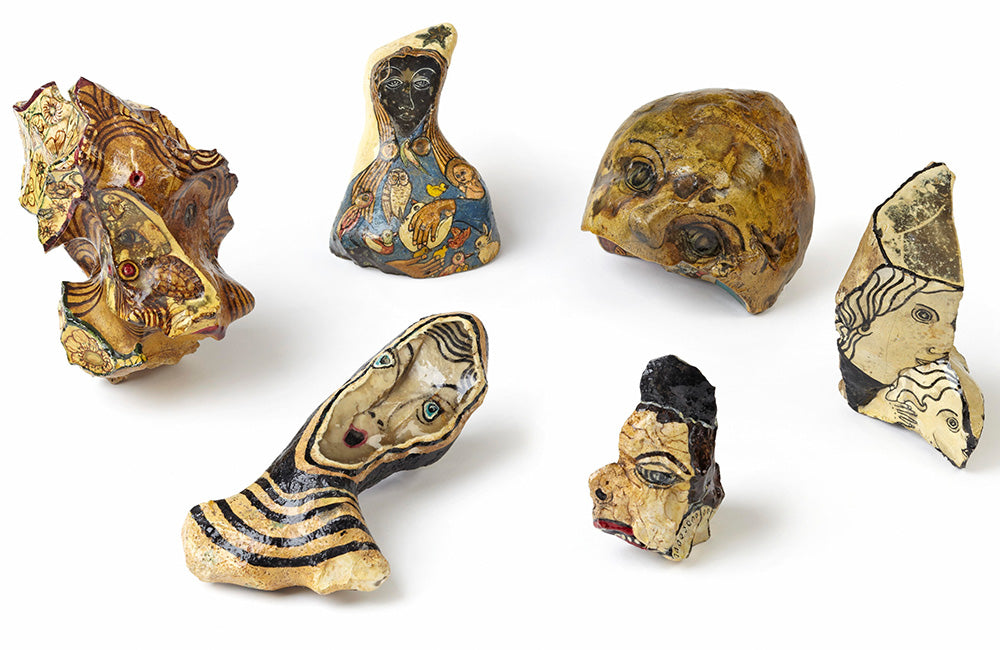First published: Summer 2020
A manuscript by British artist Gwyneth Rowlands gives fresh insight into her life and the inspirations for her multi-faceted creations
Much of what we currently know about artist Gwyneth Rowlands comes from her manuscript Fox-hunting, which she refers to as “a commentary on my life and work”. It exists as collage, with postcards, reproductions of paintings, and family photographs pasted amongst poems which she copied out longhand. Rowlands first mentioned the existence of Fox-hunting in 1995. While it is unknown when exactly she began creating the manuscript, it was almost certainly during the period after she left the psychiatric hospital in which she lived until the early 1980s, and its content is intrinsically, although not explicitly, linked to the art she created there. Rowlands edited and revised Fox-hunting up until a year before her death in 2009, and today it is held in the Edward Adamson Archive in Wellcome Collection, London, as part of a wider archive of Rowlands’ correspondence.
Born in Epsom, Surrey, in 1915, Rowlands spent her childhood in Sutton, south London. From Fox-hunting it is known that, between 1938 and 1946, she travelled widely through Europe, South America and Africa. The manuscript contains some wonderful travel writing: evocative descriptions of alabaster lamps in an Egyptian temple; a lively account of an encounter with a huge tarantula in her bath in Argentina which initiated her hunt for its mate; a period spent recovering from malaria. Of her time spent teaching Jewish children in Berlin during the rise of the Nazis in the late 1930s, Rowlands observes starkly, “And I said nothing”, yet she later reveals that she travelled back to England wearing her Jewish friend’s fur coat and jewellery in order to pass it to a brother who had already fled to the UK.
Rowlands writes little about her life after returning from her travels, except a brief passage covering her concerns about Cold War nuclear proliferation, particularly its effects on children. However, both scholarly and playful, Fox-hunting does display a wealth of cultural influences. She was particularly engaged with the poetry of Ted Hughes and Seamus Heaney. The former’s profound affinity for the animal world and the latter’s musings on the archaeological and agricultural align with the sensibilities which permeate both Rowlands’ artwork and writings.

Untitled (Woman and Child), 4.5 x 5.5 x 4 in. / 11.5 x 14 x 10.8 cm
She was admitted to Netherne psychiatric hospital in Surrey in 1962, but – other than a few pictures – her manuscript records nothing of her artistic production during her 20-year stay there. It is known, however, that Rowlands developed her painting skills while hospitalised. She worked in studios provided by Edward Adamson, an artist who was influential in the post-war reiteration of art and mental health, and the evolution of British art therapy (see Raw Vision 72). So dedicated was Rowlands to practising art that she sometimes worked through the night and over weekends, and she was entrusted to opening and closing the studio for other patients when Adamson was on leave.
Rowlands’ earliest works appear to be the product of a decorative, craft-based practice: representational paintings of birds and butterflies on pebbles brought to her from Budleigh-Salterton beach by visiting family members. There are variations in the telling of the myth of her creative epiphany but – at Adamson’s suggestion "Why don't you try something else?” – she began to collect flints from the fields surrounding the hospital and turned her hand to creating the painted objects for which she would become known.
This is an article extract; read the full article in Raw Vision #106




